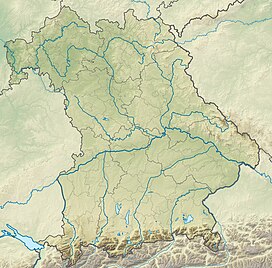Neubürg
- View a machine-translated version of the German article.
- Machine translation, like DeepL or Google Translate, is a useful starting point for translations, but translators must revise errors as necessary and confirm that the translation is accurate, rather than simply copy-pasting machine-translated text into the English Wikipedia.
- Do not translate text that appears unreliable or low-quality. If possible, verify the text with references provided in the foreign-language article.
- You must provide copyright attribution in the edit summary accompanying your translation by providing an interlanguage link to the source of your translation. A model attribution edit summary is
Content in this edit is translated from the existing German Wikipedia article at [[:de:Neubürg]]; see its history for attribution. - You may also add the template
{{Translated|de|Neubürg}}to the talk page. - For more guidance, see Wikipedia:Translation.


The Neubürg is a table hill in Mistelgau, Germany. It is part of the Franconian Jura and Franconian Switzerland.
Geography
The Neubürg is a so-called "Zeugenberg" (outlier mountain) located on the eastern edge of the Franconian Jura, 5 km southwest of the village of Mistelgau. The small village Wohnsgehaig (part of Mistelgau municipality) is located on the western slopes of Neubürg.
Geology
The Neubürg was created in the Jurassic era. The top layer consists of lime, followed by clay and iron-rich sandstone.[1]
History
Likely, the hilltop was first settled during Paleolithic around 12,000 BCE.[1]
From the Neolithic period up to the La Tène period, a fortified settlement existed on the hilltop plateau. For this reason, today, this plateau is a protected archeological monument.[2]
During the Middle Ages and until 1415, a castle atop the hill secured the road Via imperialis that ran from Bamberg to Bayreuth (and then on towards Cheb).[1]
In 1806, local residents cut down the oak wood atop the hill. Today, this gives visitors a panoramic view of the entire surrounding area from Fichtel Mountains and Bayreuth right up to the Bamberg area.[1]
In 1999, the nearby municipalities or towns Aufseß, Eckersdorf, Gesees, Glashütten, Hollfeld, Hummeltal, Mistelbach, Mistelgau, Plankenfels, and Waischenfeld, together with other agents, created the development association Förderverein Region Neubürg e. V. aimed at fostering tourism in the region.[3]
Since 2003, the hill hosts the NaturKunstRaum Neubürg (literally Nature Art Room Neubürg), a permanent exhibit of various sculptures created by artists from Germany, France and Switzerland.[4]
- v
- t
- e
References
- ^ a b c d "Die Neubürg – Neubürg" (in German). Retrieved 2021-09-10.
- ^ "Regierungsbezirk Oberfranken - Landkreis Bayreuth -Gemeinde Mistelgau" (PDF). Die bayerischen Denkmäler online - Listenauszüge (List of monuments). Munich: Bayerisches Landesamt für Denkmalpflege. pp. 5–6. Retrieved 10 September 2021.
- ^ "Der Verein – Neubürg" (in German). Retrieved 2021-09-10.
- ^ "Naturkunstraum – Neubürg" (in German). Retrieved 2021-09-10.










